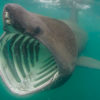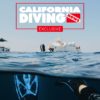There are many “best” spots in diving. If you looking for the “best” spot to see small creatures, sites in Indonesia or Papua New Guinea come to mind. The “best” spot for humpback whales has got to be Tonga. The “best” kelp beds have got to be in California. While there are several locations to view great white sharks worldwide, Isla de Guadalupe is now recognized as the best place to observe and photograph these top predators.
Guadalupe is unique among white shark diving destinations and has all a shark diver could ever ask for. First, Guadalupe is home to lots of sharks; you might have four or more at the cage at one time, and may see over a dozen different animals in three days of diving. Second, the water is very clear here, and visibility is often well over 100 feet! Third, the water is warm, averaging around 72°F. And, perhaps, best of all it is a short trip from California.
Isla de Guadalupe is located in Mexican waters, about 250 miles south of San Diego and about 100 miles offshore of Baja California. This truly remote volcanic island has towering cliffs, cinder cones, and plugs. The only human inhabitants of Guadalupe are a small contingent of Mexican sailors, and a handful of subsistence fishermen. There are, however, huge colonies of pennipeds on the island: Guadalupe fur seals, California sea lions, and elephant seals. These and the huge population of offshore tuna make this an ideal dining area for white sharks.
World-class dive/shark boats depart from both San Diego and Ensenada. Normally these boats take 16 divers with cage space for 8, so you get to spend half on the trip in a cage. Air is surface supplied, so bottom time is virtually limitless, and there are no clumsy tanks to bounce around in the cage. Usually the first shark appears shortly after the chumming begins.
Your first glimpse of a great white shark is truly a memorable experience. First, you notice a barely discernable speck in the distance that slowly assumes a shark-like appearance. Then you notice the length, perhaps as little as 9 feet, but sometimes over 16. Then you are impressed by the girth, these sharks are bigger around than you expect from their length. Lastly, you focus in on the mouth—and all those teeth.
Each shark also has its own personality. Usually the first sharks to show up are cautious, and hang out beyond the cage or underneath. Others are absolutely fearless from the very beginning and slowly swim inches from the cage. As the day progresses most become very comfortable and begin to take hang baits 10 feet or so from the cage. By the end of the day they are up close to the cage eyeing the divers within.
These sharks also have personalized hunting styles. Some will slowly and cautiously approach a hang bait, while others will move straight in. Still others are more cunning and will lurk in the depths, only to charge the bait from below with great speed and violence.
Some are sleek and clean with a flawless complexion. Others are scared by time and violent encounters with prey and other sharks. Adult female sharks usually have bite marks right behind the head. During mating males hold on to females with their teeth. Many of the male sharks nasty bite marks around the head, back and gills, presumably by other white sharks. Sharks of both sexes can have paired puncture or cut marks around their mouth, which are characteristic of pinniped bites.
Observing a great white shark from the safety of a cage has got to be one of the pinnacles of diving. But no picture or video can come close to the experience of meeting one face to face. Check out Guadalupe and you will understand just what I mean.







